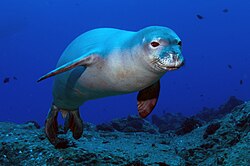| Neomonachus | |
|---|---|
 | |
| Hawaiian monk seal, Neomonachus schauinslandi | |
| Scientific classification | |
| Kingdom: | Animalia |
| Phylum: | Chordata |
| Class: | Mammalia |
| Order: | Carnivora |
| Family: | Phocidae |
| Tribe: | Monachini |
| Genus: | Neomonachus Slater & Helgen, 2014 |
| Type species | |
| Monachus schauinslandi [1] Matschie, 1905 | |
| Species | |
Neomonachus is a genus of earless seals, within the family Phocidae. It comprises two species: the endangered Hawaiian monk seal, and the extinct Caribbean monk seal. Prior to 2014, all three species of monk seals were placed in the genus Monachus , but that was found to be paraphyletic. [1]





